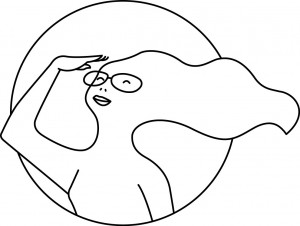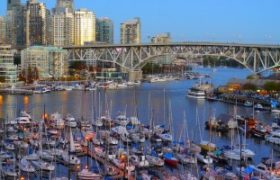“And do I get off at Waterfront station?” The question makes me eavesdrop on the conversation from the front of the Skytrain.
“Actually, you should get off one stop before, so you don’t have to walk uphill,” I interject. “I’m getting off there so I can show you if you like.”
The young woman looks surprised, but grateful. For the rest of the trip from Vancouver’s airport she grills me with questions, notebook in hand. She’s especially concerned about safety, explaining that this is her first trip outside the States. I reassure her, “In Vancouver, the biggest tourist danger is getting in the way of a cyclist on the bike path.”
Off the train and out on the downtown streets, I point her toward the glowing sign of her hotel and wish her a good visit. She thanks me profusely, exclaiming that she can’t believe how nice people here are. I shrug, “Yup, this is Canada. Everyone is nice.”
Ideal Introduction to International Travel
As this American tourist would attest, Vancouver is the perfect introduction to traveling abroad. An hour’s drive from the border with Washington State, Vancouver is similar enough to most U.S. cities that you won’t be disoriented. But it is just different enough that you know you’re in another country.
Vancouver’s streets will look familiar to most Americans. Nicknamed Hollywood North, the city subs in for the United States in countless TV shows and movies. However, the majestic mountains and waterways surrounding the city will be delightfully new. Also new will be the friendliness of Canadians. Despite living in Canada’s third largest city, Vancouverites are always happy to give directions and sightseeing advice to visitors.
For Americans, the most difficult changes to adjust to are numbers-related. Temperatures are in Celsius rather than Fahrenheit—a typical summer day will be 25℃ rather than 77℉. The Canadian dollar is currently worth about $1.25 U.S, so Americans get a bigger bang for their buck (though note there is a 12 percent sales tax on most goods and services). Canadian currency is also brightly coloured, and we have coins—loonies and toonies—instead of $1 and $2 bills.
Shopping and Dining
With the additional buying power of the U.S. dollar, Vancouver is a good place to stock up on favorite brands and try new things.
Familiar chain stores are interspersed with Canadian specialties such as the luxurious Holt Renfrew; iconic department store Hudson’s Bay; Canada’s epicenter for outdoor gear and apparel Mountain Equipment Co-op; First Nations art; the original Lululemon; and endless independent boutiques and ateliers. Granville Island, known as Vancouver’s town square, has a public market, artisans’ studios, shops, galleries, and restaurants.
Dining can be as prudent or adventurous as you like. The city has an abundance of street food, coffee houses, bakeries, holes in the wall, tasting rooms, patios, rooftop bars, and fine dining rooms. Almost all of them take advantage of British Columbia’s (BC) local products, including its wineries.
With its coastal location, Vancouver is especially famous for its fresh seafood. I highly recommend the spot prawns—a wild, sustainable, local shrimp—which are in season May to July. BC cherries are, in my opinion, the very best in the world and available all summer. Edible Canada, a restaurant and food shop on Granville Island, showcases the best Canadian and BC products.
Vancouver’s restaurant scene reflects its status as one of Canada’s most multicultural cities. Visitors wanting a taste of China flock to the suburb of Richmond, near the airport. Food critics claim it has the best Chinese cuisine in the world. The intersection of Robson and Denman streets close to Stanley Park is famous for Korean cuisine. Sushi might be Vancouverites’ favourite food and you’ll find cheap and high-end versions everywhere.
Vancouver has a large Indian population with cuisine to match. Vikram Vij and Meeru Dhalwala are famous for their traditionally prepared Indian dishes using local and sustainable ingredients. They have several restaurants, including two which have all-women kitchen staff: Vij’s and Rangoli.
Vancouver even has a restaurant serving cuisine from Canada’s First Nations (indigenous) peoples. The menu at Salmon n’ Bannock Bistro creatively showcases indigenous ingredients and flavors in modern preparations.
If you can think of it, you can eat it in Vancouver.
Arts and Culture
Vancouver is western Canada’s epicentre for culture. The city has more than 50 professional theatre companies and several theatre festivals. Singers and bands often kick off their world tours here, and smaller acts play live every night of the week. There’s street art, art galleries, and museums galore.
Festivals include those for fireworks, dragon boats, writers and readers, music, film, gardens, food, wine, and one of the largest gay pride parades on the continent. There’s even annual pillow fights, zombie walks, no-pants Skytrain rides, and naked bike rides.
Outdoor Adventures
Despite being a big city, Vancouver is an outdoor paradise. Locals and tourists alike delight in walking and biking along the Seawall, which borders much of the downtown peninsula. The Seawall also surrounds Stanley Park, an urban rainforest bigger than New York’s Central Park. Along the Seawall, sightings of eagles, herons, raccoons, sea lions, and Canada geese are common. On rare occasions, even orca and grey whales come close to shore.
From March to October, a whale-watching trip almost guarantees sightings of humpbacks, orcas, grey whales, or minke whales. Visit the Vancouver Aquarium, Canada’s only marine mammal rescue center, at any time of the year to see sea otters, sea lions, a Pacific white-sided dolphin, and a false killer whale, all either born in aquariums or rescued from the ocean.
Time Magazine named Vancouver one of the healthiest places to live. Hiking, running, and biking are every-day activities for many, and Vancouver’s fittest brag about their record times climbing “Mother Nature’s Stairmaster”, the 1.8-mile, 2,830-step Grouse Grind.
If you’re more interested in the views than the workout, take the 1-mile gondola ride up Grouse Mountain ($32 US). Whether in winter or summer the scenery is stunning, particularly at sunset. You’ll see downtown and Stanley Park, English Bay and False Creek, and even out to the Gulf Islands. Atop the mountain there’s winter skiing, skating, snowshoeing, and sleigh rides, and summer hiking, ziplines, disc golf, and paragliding.
Also accessible from Vancouver’s North Shore is the Capilano Suspension Bridge ($30 US). This park provides a rainforest experience walking at squirrel-height between cedar trees 110-feet above the forest floor, a labyrinth-like cantilevered CliffWalk, and the 230-foot swinging bridge over the Capilano River.
Down at sea level, the city is ideal for walking. Flowers bloom year-round, even when the thermometer hovers near freezing in January. Cherry blossoms scent the air for months in the spring and the autumn colors are beautiful. Chinatown has the first classical scholars’ garden built outside of China. VanDusen Botanical Gardens is a favorite spot with ecosystems representing the Mediterranean, Himalayas, Louisiana swamps, and, of course, the Pacific Coast.
Vancouver: Ideal Mix of the Familiar and the Exotic
Vancouver’s multicultural nature and varied sites give visitors a true international flavor. But you’ll feel at home, and Canadians are overwhelmingly welcoming and polite to visitors. Just don’t say you can’t tell the difference between us and Americans. Then it isn’t just the cyclists on the bike path you’ll need to watch out for.
If You Go
Where to stay
- The Sylvia Hotel (1-877-681-9321): Looking out over English Bay near Stanley Park, this boutique hotel in a heritage building is a city landmark. From $140 US.
- O Canada House Bed & Breakfast (1-877-688-1114). One of the first versions of Canada’s national anthem, O Canada, was written in this Queen Anne-style house. It’s within walking distance of all the downtown neighbourhoods. From $180 US.
- OPUS Vancouver (1-866-642-6787). Across the street from a Skytrain station from the airport, this luxury design hotel is in trendy downtown Yaletown and close to False Creek. From $250 US.
What to do: Tourism Vancouver has lots of trip planning tools.
Transportation: The Skytrain is the quickest and cheapest way from Vancouver International Airport to downtown. Buy a Compass Card at the track-side kiosk; the peak hours fare is $9 Canadian (about $6.75 US). The $5 airport premium fee doesn’t apply for trips back to the airport.


Leave a Reply